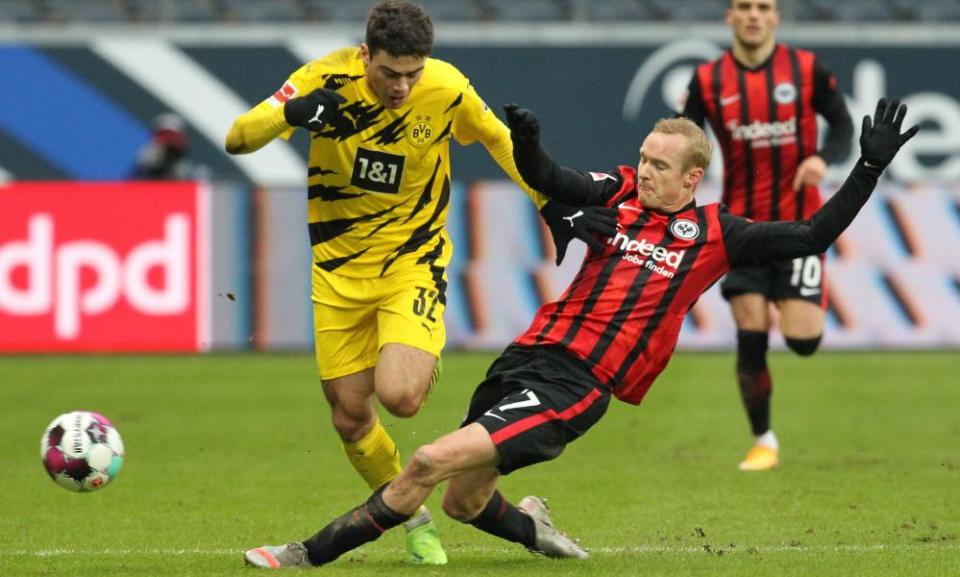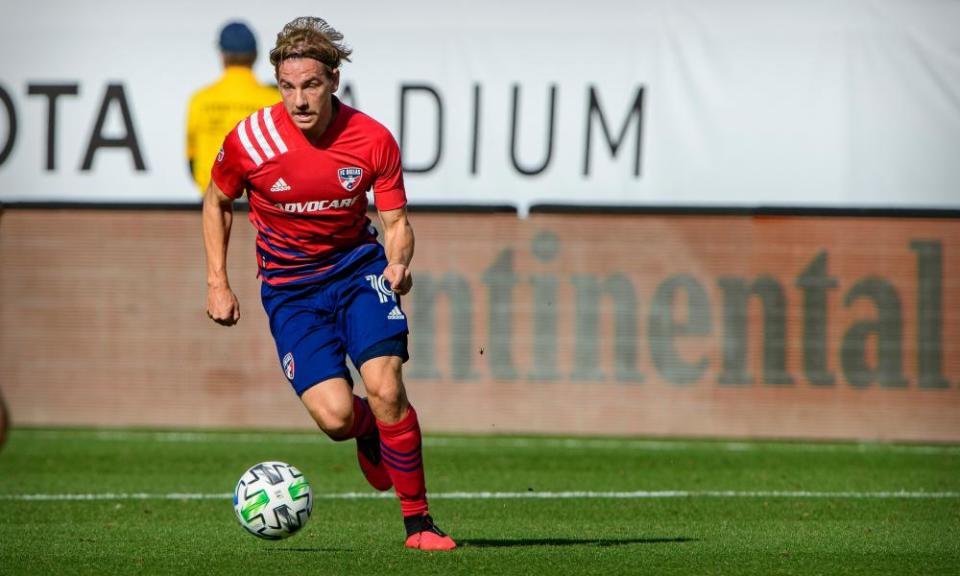'Can we contend in 2026? Absolutely': The rise of the USMNT in their own words

From Weston McKennie shining alongside Cristiano Ronaldo for Juventus to Chris Richards making inroads at Bayern Munich, from Christian Pulisic starring for Chelsea to Matthew Hoppe’s free-scoring Bundesliga breakthrough – there are more American players thriving at soccer’s highest levels than ever before.
With a large number of these young stars already playing key roles at some of the biggest clubs in the world, the future of the United States men’s national team has never appeared so bright. The 2026 World Cup on home soil is on the horizon and excitement is building around this gifted generation.
Here, five top young American soccer talents – from the Bundesliga, Premier League and MLS – and USMNT manager Gregg Berhalter share their thoughts on how and why this gilded crop has emerged, the legacy they hope to build and how far they can go in 2026.
What do you think are the main reasons behind so many talented young American players emerging over the last few years?
Giovanni Reyna (age: 18; club: Borussia Dortmund – two international caps): I think it has just been a growth of the sport in America. More and more kids are playing it and the overall growth of the sport in America is leading to more and more players coming out.
Related: USA put seven past Trinidad and Tobago as MLS-based players shine
Chris Richards (20; Bayern Munich – one cap): I definitely think Christian Pulisic was a trailblazer. He was a guy around our age who first made the jump. It helped us realise, if he can do it, why can’t we?
Tyler Adams (21; RB Leipzig – 12 caps): You’re seeing a lot of young talent now being trusted and given the opportunity to play minutes and prove what they’re capable of. Now a lot of players are coming to Germany because they see that a lot of German coaches are trusting in the process of developing young American talent.
Zack Steffen (25; Manchester City – 19 caps): I would say maybe better coaching. Soccer is evolving over in America, and Americans are starting to see it as Europeans see it.
Paxton Pomykal (21; FC Dallas – one cap): When you’re a kid, you grow up and want to make a lot of money. Fifteen years ago, you couldn’t do that here [playing soccer] in the States, and now you can. I feel like a lot of guys are seeing the success that people are having overseas and the way that youth academies have developed over the past 10 years.
Gregg Berhalter, USMNT manager: It’s a direct result of two things. The first thing would be the creation of the Development Academy by US Soccer, which created a platform for the best to play against the best. That started about 14 years ago. The second thing is the investment from MLS owners in youth development. We all know development is a long-term strategy. Now we’re seeing the fruits of that labour, just about 10 years later. There has been a significant investment in academies, and we’re seeing the results of that.
Failure to qualify for the 2018 World Cup was a dark moment for US soccer. How did the younger generation of American players react to that?
Richards: I remember sitting at home and watching the game on ESPN. Just realising that we weren’t going to be in the next World Cup, it was pretty devastating. I think for us younger guys, it really made us wake up and realise we never want that to happen again. It really made us work harder. And I think that’s why we see so many Americans over here in Europe now. Because of that failure to qualify, we want to be able to show that we can do it. We want to do more than just be in the World Cup; we want to win it. It definitely helped give us a kick in the butt to show we can do it.
Pomykal: At that point in time I was with the Under-18 national team, and it hurt us at camps where we’d go. We’d kind of have a chip on our shoulder to prove that that’s now what the US men’s national team is, and that’s not how we should be viewed on a world scale. If you look around the world, I’m sure that teams were writing us off for the next 10 years. I think we took that to heart.
Related: USA's Weston McKennie: how the Juve starlet leads on and off the pitch
Berhalter: It was obviously a step back, when you think about the overall impact on US Soccer. But it wasn’t crippling, because of the fact these youth-development initiatives were already underway and a lot of the groundwork had already been set. What I think it provided was motivation for this next generation of players to be hungry and say, “OK, we want more and we can do more. We’re going to put our energy into getting us back where we belong.”
Has the breakthrough of American players in Europe been important for US soccer’s development?
Reyna: It has been the most important thing for development in America – these are people that young kids could look up to. Just a few years ago, I was watching Christian Pulisic do really well here at Dortmund; that definitely played a role with me wanting to come to Europe and especially Dortmund. A lot of it has an influence on young kids. It gives belief to young kids in America that they can do it too.
Richards: I think having a lot of players over here in Europe has shown not just kids who want to play soccer but kids who grow up playing any sport that we can be the best players in the world at whatever we do. Especially around my area of the woods back home, it’s helped inspire the next generation of kids. They don’t know what sport they want to do, and it’s allowed them to give soccer a try.
Adams: You have players week in and week out playing in the top competitions in the world, playing in the Champions League. This is very important because now the younger and younger generations of American soccer want to do that as well.
Steffen: It’s massive. Guys came over here, in the best leagues, in the best teams, getting minutes. In games, you get a lot of experience, you get a confidence. You obviously get better and you learn a lot. We need more guys to do it.
Pomykal: Absolutely. MLS is progressing at its own rate and has gotten a lot better in the past 10 to 15 years, but it doesn’t compare to a top-five league in Europe. If you look right across the board, we have more players playing in top-five leagues in Europe than we ever had in the past, more guys playing in Champions League games than we ever had in the past. Most of those guys also are pretty young, under 24 or 25, so they have long careers ahead of them. In 10 years, they’ll be 34, still playing at a high level, and there will be 10-year-olds now who are 20, trying to do the things they are now. For them to be able to set that standard for the next generation, it’s going to be really important for the next guys coming up.
Berhalter: One hundred per cent. It brings a lot of attention to soccer in the United States. It’s great to watch English Premier League games, but it’s even better to watch it when you’ve got Americans playing in it. It certainly raised more attention for these big leagues around the world, raised more attention for MLS. It’s focused a lot of international leagues on Major League Soccer in looking for that next talent.
How important will the 2026 World Cup on home soil be for the growth of soccer in the US?
Reyna: The tournament is really going to be special, to have all our families and friends there at all the games. Bringing the game to America will help it grow a lot. The national coverage and the whole stage of the World Cup in America, it’s a great step for US soccer. Hopefully many kids will be watching and getting inspired not just by Americans but by some of the best players from around the world.
Pomykal: I think it’ll be massive. Hopefully I’ll be in it, but if not I’ll go to games. But also for people who don’t understand the game and don’t realise it’s the biggest sport in the world. To have that big of a stage in their own country and have us be successful is the next step to help soccer become a dominant sport in the US.
Berhalter: I think it’s going to be another step, another important step. When you add all these factors together, it’s leading us to a point where soccer can become a very popular sport in America. That’s what we’re striving for.
Can the US be a genuine contender in 2026?

Reyna: That’s a tough question. Winning the World Cup obviously is not easy at all. There’s a lot of time until then. We have to see how things develop. But I’m sure our young generation now will be in the prime of our careers then. I think with home fans, anything is possible.
Richards: Yeah, definitely so. You see a lot of guys here, we’re really young. Hopefully, around 2026 we’ll be in our primes. We want to win every tournament.
Adams: I think that we can be a real contender. Going into it at a prime age – myself, I’ll be 26; some of the other players will be 27, some even younger – it will be huge for some of us to have the experience behind our back of, hopefully, the 2022 World Cup and then maybe raising one in our home county. So yes, I think we can be a contender in the 2026 World Cup.
Related: Chris Richards' journey from Dallas to Munich: 'I knew I'd be balling at Bayern'
Steffen: Yes, I believe so. It’s five years from now. As long as we keep putting in the work every day, getting better, accomplishing challenges and goals and still striving to become better, we can definitely contend for the title in 2026.
Pomykal: Absolutely. We have a really talented group that I know Gregg [Berhalter] is going to get ready for that tournament. I know the guys are looking forward to it.
Berhalter: The short answer is yes. The longer answer is: there’s a lot of work to be done to actually get there. It’s a lot easier to say than to actually do it. Our first step is to qualify for the 2022 World Cup. And then it’s to perform well at the 2022 World Cup. And then from there, the next step would be to contend in 2026. When I look at this generation of players, it’s going to be in its prime in 2026. I would say that when you have quality, when you have players in their prime, you have an opportunity to contend for 2026.

